Leadership Style's Effect on Employee Performance at Al-Ghazi
VerifiedAdded on 2023/06/13
|8
|1513
|497
Report
AI Summary
This report investigates the effect of leadership styles on employee performance within Al-Ghazi Tractor Factory, addressing problems such as low productivity and poor creativity attributed to inadequate leadership. It aims to identify leadership styles that enhance employee performance, differentiate between employee and leadership performance, and highlight the importance of effective leadership. The study employs a methodology involving literature review and secondary data analysis to explore the relationship between various leadership styles and employee outcomes. It defines leadership as a process of guiding and influencing employees to achieve organizational goals, emphasizing the importance of leaders in managing change and improving performance. The research seeks to provide insights for leaders and organizations, particularly in Pakistan and developing countries, to improve employee performance through strategic leadership interventions.

Running Head: EFFECT OF LEADERSHIP STYLE ON EMPLOYEE PERFORMANCE 1
Analysis of Effect of Leadership Styles, their influence on behavior of Employees, their
implementation processes and impact on employee Performance in Al-Ghazi Tractor Factory.
Name
Course
Tutor
Analysis of Effect of Leadership Styles, their influence on behavior of Employees, their
implementation processes and impact on employee Performance in Al-Ghazi Tractor Factory.
Name
Course
Tutor
Paraphrase This Document
Need a fresh take? Get an instant paraphrase of this document with our AI Paraphraser
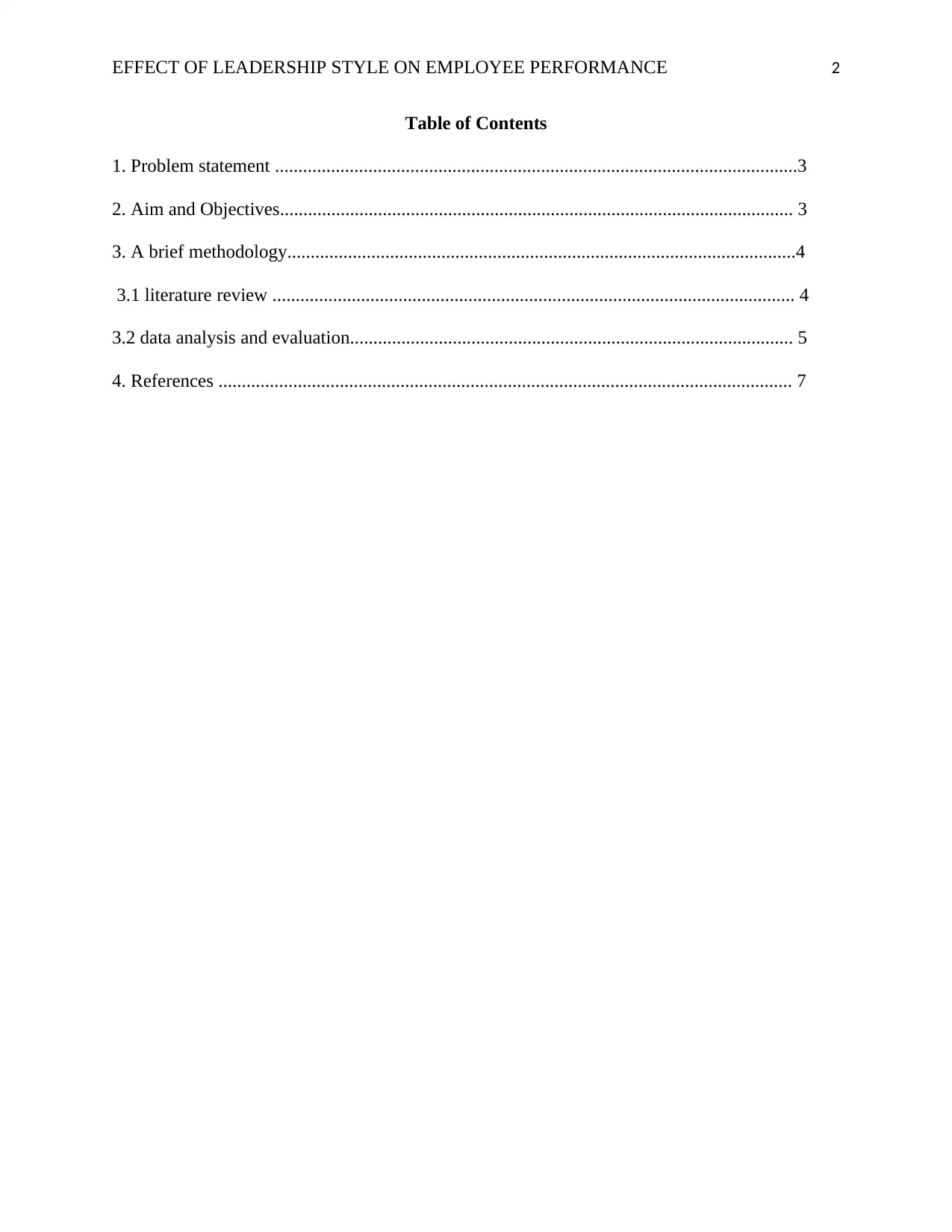
EFFECT OF LEADERSHIP STYLE ON EMPLOYEE PERFORMANCE 2
Table of Contents
1. Problem statement ................................................................................................................3
2. Aim and Objectives.............................................................................................................. 3
3. A brief methodology.............................................................................................................4
3.1 literature review ................................................................................................................ 4
3.2 data analysis and evaluation............................................................................................... 5
4. References ........................................................................................................................... 7
Table of Contents
1. Problem statement ................................................................................................................3
2. Aim and Objectives.............................................................................................................. 3
3. A brief methodology.............................................................................................................4
3.1 literature review ................................................................................................................ 4
3.2 data analysis and evaluation............................................................................................... 5
4. References ........................................................................................................................... 7

EFFECT OF LEADERSHIP STYLE ON EMPLOYEE PERFORMANCE 3
1. Problem statement
The performance of workers entails execution of duties such as, competency among
employees, meeting of deadlines, and efficiency together with effectiveness in working
(Oskar, 2017). Great leadership styles are highly needed by almost every organization to
enhance the importance of employees (Butt, 2018). Some of the problems faced by
organizations, for example, the tractor factory include: productivity which is less, poor
creativity, poor employee performance. These problems are brought up by lack of proper
leadership styles interventions. These problems have continuously affected the employee
performance.
It has been noted that behind every successful organization there is a strategic leadership
style (Bouckenooghe 2015). When we look at the world of technology, the initiative of good
leadership management is highly adopted. In an organization, the employees value the fact that
leaders do not only need to lead employees but should also exercise effectiveness. All employees
need a leader who can swiftly manage changes and improvement of performance in an
organization (Ahmad, 2014).
Having a look at the performance of both the employees and the firm, how should the leader
perform?
How can performance be changed by the effectiveness of the leader?
2. Aims and objectives
1. To have a look at the leadership styles that adds to the performance of employees.
2. To bring out the differences existing between employee performance and leadership
performance.
3. To outline the importance of leadership effectiveness on employee performance’
1. Problem statement
The performance of workers entails execution of duties such as, competency among
employees, meeting of deadlines, and efficiency together with effectiveness in working
(Oskar, 2017). Great leadership styles are highly needed by almost every organization to
enhance the importance of employees (Butt, 2018). Some of the problems faced by
organizations, for example, the tractor factory include: productivity which is less, poor
creativity, poor employee performance. These problems are brought up by lack of proper
leadership styles interventions. These problems have continuously affected the employee
performance.
It has been noted that behind every successful organization there is a strategic leadership
style (Bouckenooghe 2015). When we look at the world of technology, the initiative of good
leadership management is highly adopted. In an organization, the employees value the fact that
leaders do not only need to lead employees but should also exercise effectiveness. All employees
need a leader who can swiftly manage changes and improvement of performance in an
organization (Ahmad, 2014).
Having a look at the performance of both the employees and the firm, how should the leader
perform?
How can performance be changed by the effectiveness of the leader?
2. Aims and objectives
1. To have a look at the leadership styles that adds to the performance of employees.
2. To bring out the differences existing between employee performance and leadership
performance.
3. To outline the importance of leadership effectiveness on employee performance’
⊘ This is a preview!⊘
Do you want full access?
Subscribe today to unlock all pages.

Trusted by 1+ million students worldwide
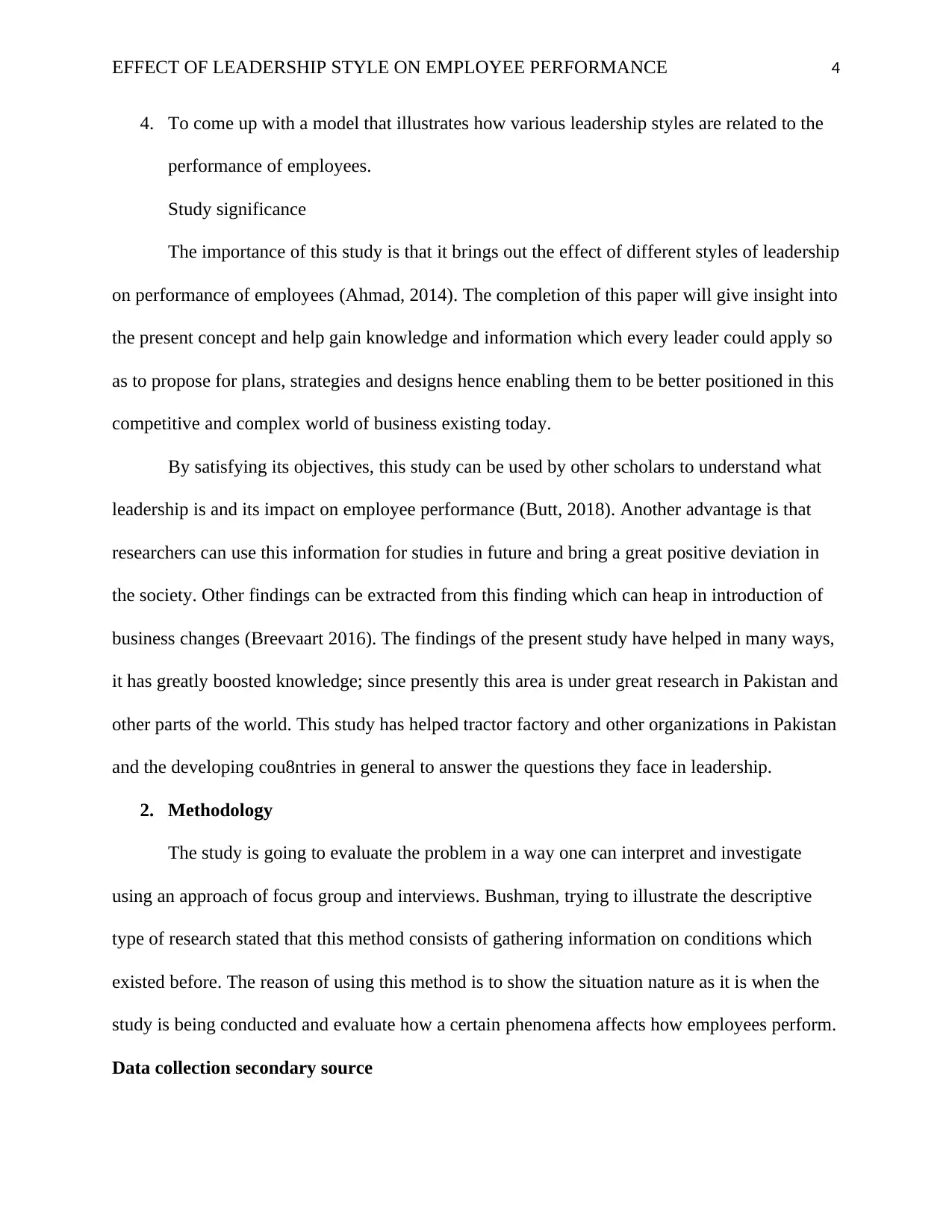
EFFECT OF LEADERSHIP STYLE ON EMPLOYEE PERFORMANCE 4
4. To come up with a model that illustrates how various leadership styles are related to the
performance of employees.
Study significance
The importance of this study is that it brings out the effect of different styles of leadership
on performance of employees (Ahmad, 2014). The completion of this paper will give insight into
the present concept and help gain knowledge and information which every leader could apply so
as to propose for plans, strategies and designs hence enabling them to be better positioned in this
competitive and complex world of business existing today.
By satisfying its objectives, this study can be used by other scholars to understand what
leadership is and its impact on employee performance (Butt, 2018). Another advantage is that
researchers can use this information for studies in future and bring a great positive deviation in
the society. Other findings can be extracted from this finding which can heap in introduction of
business changes (Breevaart 2016). The findings of the present study have helped in many ways,
it has greatly boosted knowledge; since presently this area is under great research in Pakistan and
other parts of the world. This study has helped tractor factory and other organizations in Pakistan
and the developing cou8ntries in general to answer the questions they face in leadership.
2. Methodology
The study is going to evaluate the problem in a way one can interpret and investigate
using an approach of focus group and interviews. Bushman, trying to illustrate the descriptive
type of research stated that this method consists of gathering information on conditions which
existed before. The reason of using this method is to show the situation nature as it is when the
study is being conducted and evaluate how a certain phenomena affects how employees perform.
Data collection secondary source
4. To come up with a model that illustrates how various leadership styles are related to the
performance of employees.
Study significance
The importance of this study is that it brings out the effect of different styles of leadership
on performance of employees (Ahmad, 2014). The completion of this paper will give insight into
the present concept and help gain knowledge and information which every leader could apply so
as to propose for plans, strategies and designs hence enabling them to be better positioned in this
competitive and complex world of business existing today.
By satisfying its objectives, this study can be used by other scholars to understand what
leadership is and its impact on employee performance (Butt, 2018). Another advantage is that
researchers can use this information for studies in future and bring a great positive deviation in
the society. Other findings can be extracted from this finding which can heap in introduction of
business changes (Breevaart 2016). The findings of the present study have helped in many ways,
it has greatly boosted knowledge; since presently this area is under great research in Pakistan and
other parts of the world. This study has helped tractor factory and other organizations in Pakistan
and the developing cou8ntries in general to answer the questions they face in leadership.
2. Methodology
The study is going to evaluate the problem in a way one can interpret and investigate
using an approach of focus group and interviews. Bushman, trying to illustrate the descriptive
type of research stated that this method consists of gathering information on conditions which
existed before. The reason of using this method is to show the situation nature as it is when the
study is being conducted and evaluate how a certain phenomena affects how employees perform.
Data collection secondary source
Paraphrase This Document
Need a fresh take? Get an instant paraphrase of this document with our AI Paraphraser
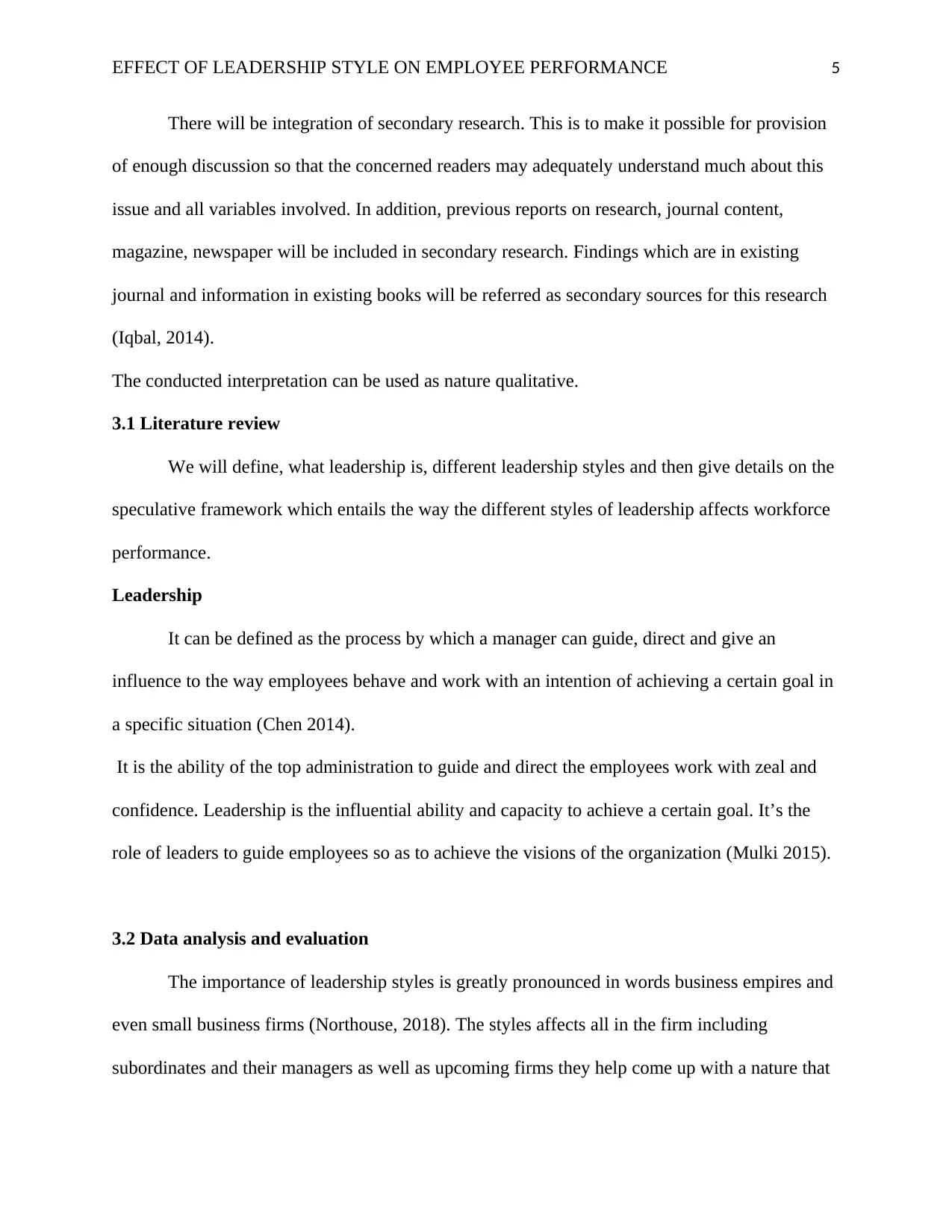
EFFECT OF LEADERSHIP STYLE ON EMPLOYEE PERFORMANCE 5
There will be integration of secondary research. This is to make it possible for provision
of enough discussion so that the concerned readers may adequately understand much about this
issue and all variables involved. In addition, previous reports on research, journal content,
magazine, newspaper will be included in secondary research. Findings which are in existing
journal and information in existing books will be referred as secondary sources for this research
(Iqbal, 2014).
The conducted interpretation can be used as nature qualitative.
3.1 Literature review
We will define, what leadership is, different leadership styles and then give details on the
speculative framework which entails the way the different styles of leadership affects workforce
performance.
Leadership
It can be defined as the process by which a manager can guide, direct and give an
influence to the way employees behave and work with an intention of achieving a certain goal in
a specific situation (Chen 2014).
It is the ability of the top administration to guide and direct the employees work with zeal and
confidence. Leadership is the influential ability and capacity to achieve a certain goal. It’s the
role of leaders to guide employees so as to achieve the visions of the organization (Mulki 2015).
3.2 Data analysis and evaluation
The importance of leadership styles is greatly pronounced in words business empires and
even small business firms (Northouse, 2018). The styles affects all in the firm including
subordinates and their managers as well as upcoming firms they help come up with a nature that
There will be integration of secondary research. This is to make it possible for provision
of enough discussion so that the concerned readers may adequately understand much about this
issue and all variables involved. In addition, previous reports on research, journal content,
magazine, newspaper will be included in secondary research. Findings which are in existing
journal and information in existing books will be referred as secondary sources for this research
(Iqbal, 2014).
The conducted interpretation can be used as nature qualitative.
3.1 Literature review
We will define, what leadership is, different leadership styles and then give details on the
speculative framework which entails the way the different styles of leadership affects workforce
performance.
Leadership
It can be defined as the process by which a manager can guide, direct and give an
influence to the way employees behave and work with an intention of achieving a certain goal in
a specific situation (Chen 2014).
It is the ability of the top administration to guide and direct the employees work with zeal and
confidence. Leadership is the influential ability and capacity to achieve a certain goal. It’s the
role of leaders to guide employees so as to achieve the visions of the organization (Mulki 2015).
3.2 Data analysis and evaluation
The importance of leadership styles is greatly pronounced in words business empires and
even small business firms (Northouse, 2018). The styles affects all in the firm including
subordinates and their managers as well as upcoming firms they help come up with a nature that
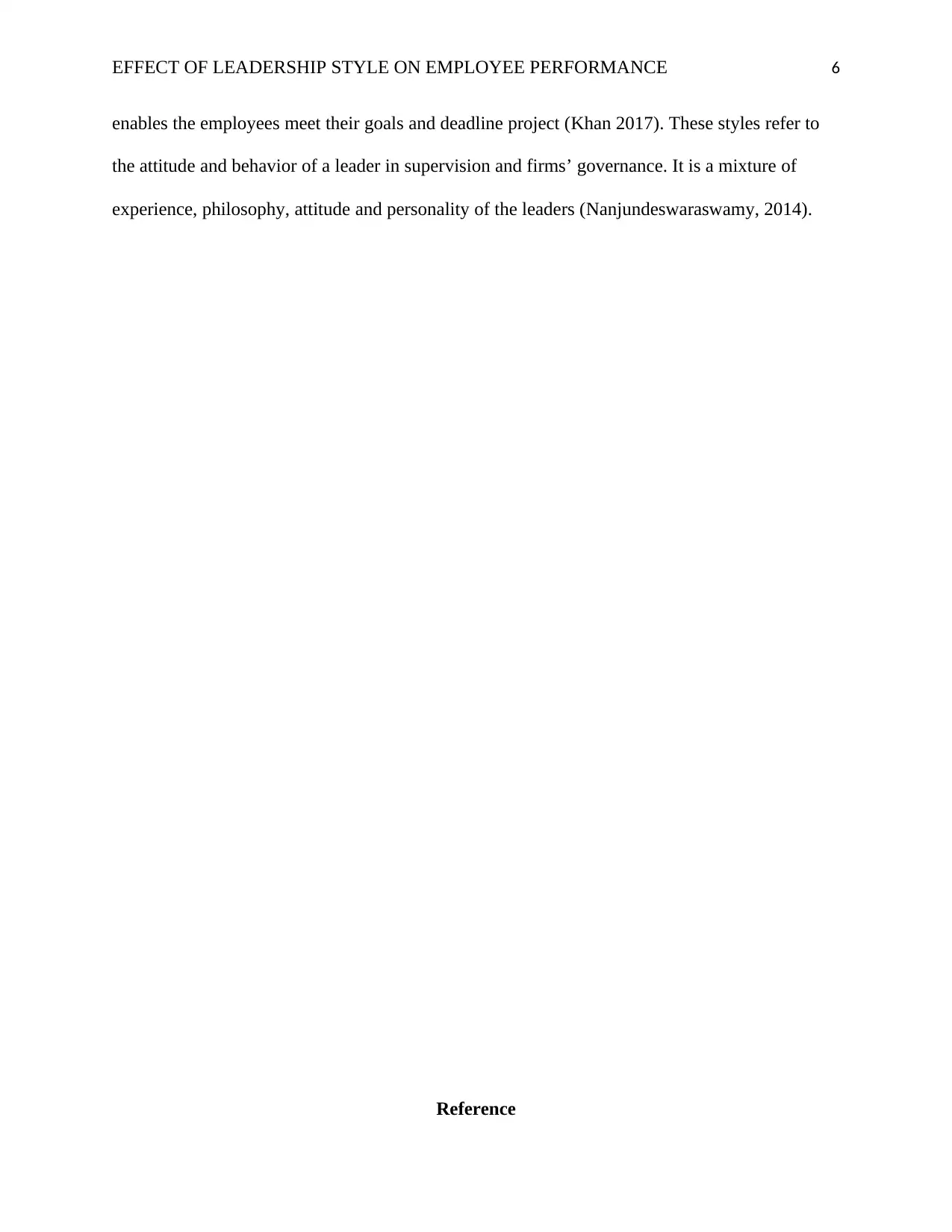
EFFECT OF LEADERSHIP STYLE ON EMPLOYEE PERFORMANCE 6
enables the employees meet their goals and deadline project (Khan 2017). These styles refer to
the attitude and behavior of a leader in supervision and firms’ governance. It is a mixture of
experience, philosophy, attitude and personality of the leaders (Nanjundeswaraswamy, 2014).
Reference
enables the employees meet their goals and deadline project (Khan 2017). These styles refer to
the attitude and behavior of a leader in supervision and firms’ governance. It is a mixture of
experience, philosophy, attitude and personality of the leaders (Nanjundeswaraswamy, 2014).
Reference
⊘ This is a preview!⊘
Do you want full access?
Subscribe today to unlock all pages.

Trusted by 1+ million students worldwide
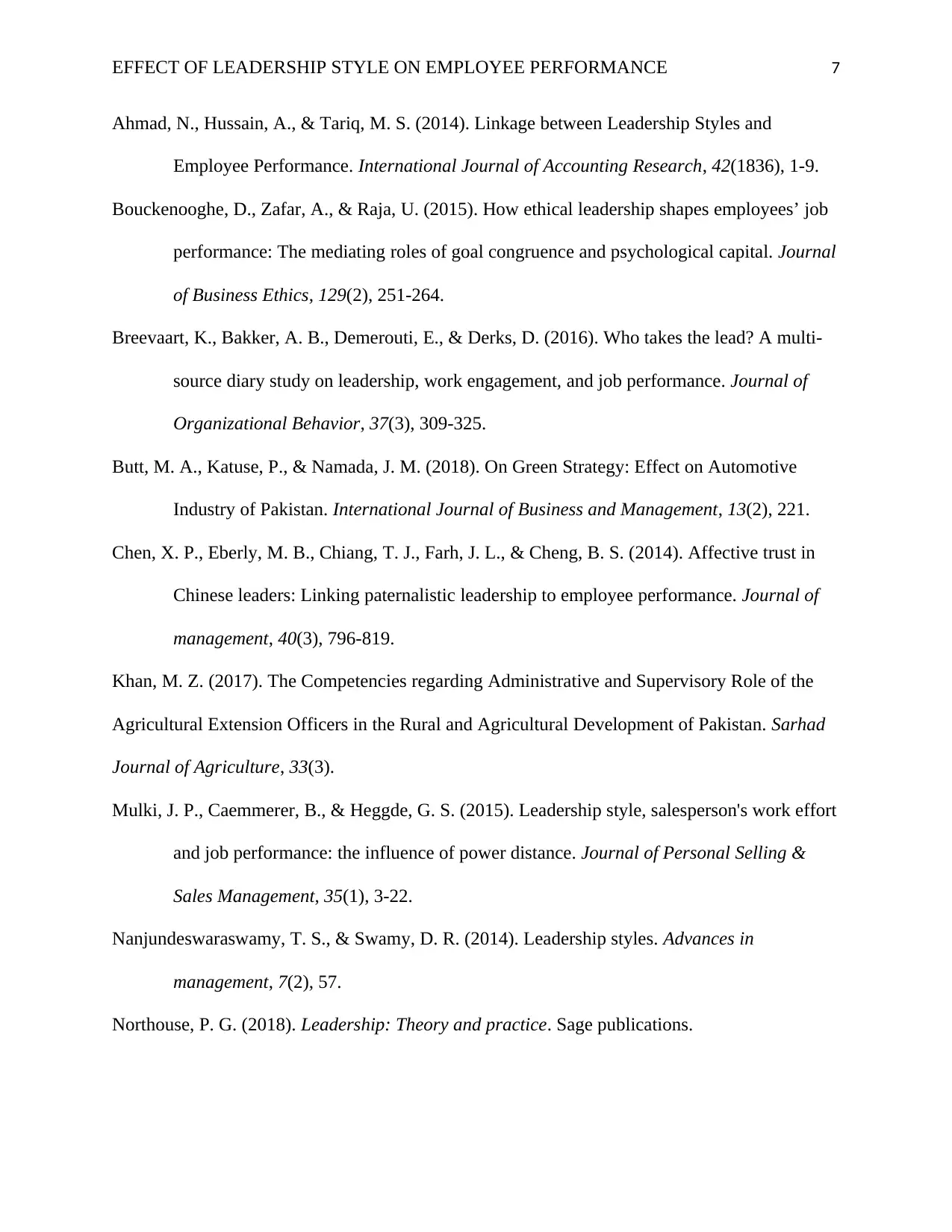
EFFECT OF LEADERSHIP STYLE ON EMPLOYEE PERFORMANCE 7
Ahmad, N., Hussain, A., & Tariq, M. S. (2014). Linkage between Leadership Styles and
Employee Performance. International Journal of Accounting Research, 42(1836), 1-9.
Bouckenooghe, D., Zafar, A., & Raja, U. (2015). How ethical leadership shapes employees’ job
performance: The mediating roles of goal congruence and psychological capital. Journal
of Business Ethics, 129(2), 251-264.
Breevaart, K., Bakker, A. B., Demerouti, E., & Derks, D. (2016). Who takes the lead? A multi‐
source diary study on leadership, work engagement, and job performance. Journal of
Organizational Behavior, 37(3), 309-325.
Butt, M. A., Katuse, P., & Namada, J. M. (2018). On Green Strategy: Effect on Automotive
Industry of Pakistan. International Journal of Business and Management, 13(2), 221.
Chen, X. P., Eberly, M. B., Chiang, T. J., Farh, J. L., & Cheng, B. S. (2014). Affective trust in
Chinese leaders: Linking paternalistic leadership to employee performance. Journal of
management, 40(3), 796-819.
Khan, M. Z. (2017). The Competencies regarding Administrative and Supervisory Role of the
Agricultural Extension Officers in the Rural and Agricultural Development of Pakistan. Sarhad
Journal of Agriculture, 33(3).
Mulki, J. P., Caemmerer, B., & Heggde, G. S. (2015). Leadership style, salesperson's work effort
and job performance: the influence of power distance. Journal of Personal Selling &
Sales Management, 35(1), 3-22.
Nanjundeswaraswamy, T. S., & Swamy, D. R. (2014). Leadership styles. Advances in
management, 7(2), 57.
Northouse, P. G. (2018). Leadership: Theory and practice. Sage publications.
Ahmad, N., Hussain, A., & Tariq, M. S. (2014). Linkage between Leadership Styles and
Employee Performance. International Journal of Accounting Research, 42(1836), 1-9.
Bouckenooghe, D., Zafar, A., & Raja, U. (2015). How ethical leadership shapes employees’ job
performance: The mediating roles of goal congruence and psychological capital. Journal
of Business Ethics, 129(2), 251-264.
Breevaart, K., Bakker, A. B., Demerouti, E., & Derks, D. (2016). Who takes the lead? A multi‐
source diary study on leadership, work engagement, and job performance. Journal of
Organizational Behavior, 37(3), 309-325.
Butt, M. A., Katuse, P., & Namada, J. M. (2018). On Green Strategy: Effect on Automotive
Industry of Pakistan. International Journal of Business and Management, 13(2), 221.
Chen, X. P., Eberly, M. B., Chiang, T. J., Farh, J. L., & Cheng, B. S. (2014). Affective trust in
Chinese leaders: Linking paternalistic leadership to employee performance. Journal of
management, 40(3), 796-819.
Khan, M. Z. (2017). The Competencies regarding Administrative and Supervisory Role of the
Agricultural Extension Officers in the Rural and Agricultural Development of Pakistan. Sarhad
Journal of Agriculture, 33(3).
Mulki, J. P., Caemmerer, B., & Heggde, G. S. (2015). Leadership style, salesperson's work effort
and job performance: the influence of power distance. Journal of Personal Selling &
Sales Management, 35(1), 3-22.
Nanjundeswaraswamy, T. S., & Swamy, D. R. (2014). Leadership styles. Advances in
management, 7(2), 57.
Northouse, P. G. (2018). Leadership: Theory and practice. Sage publications.
Paraphrase This Document
Need a fresh take? Get an instant paraphrase of this document with our AI Paraphraser
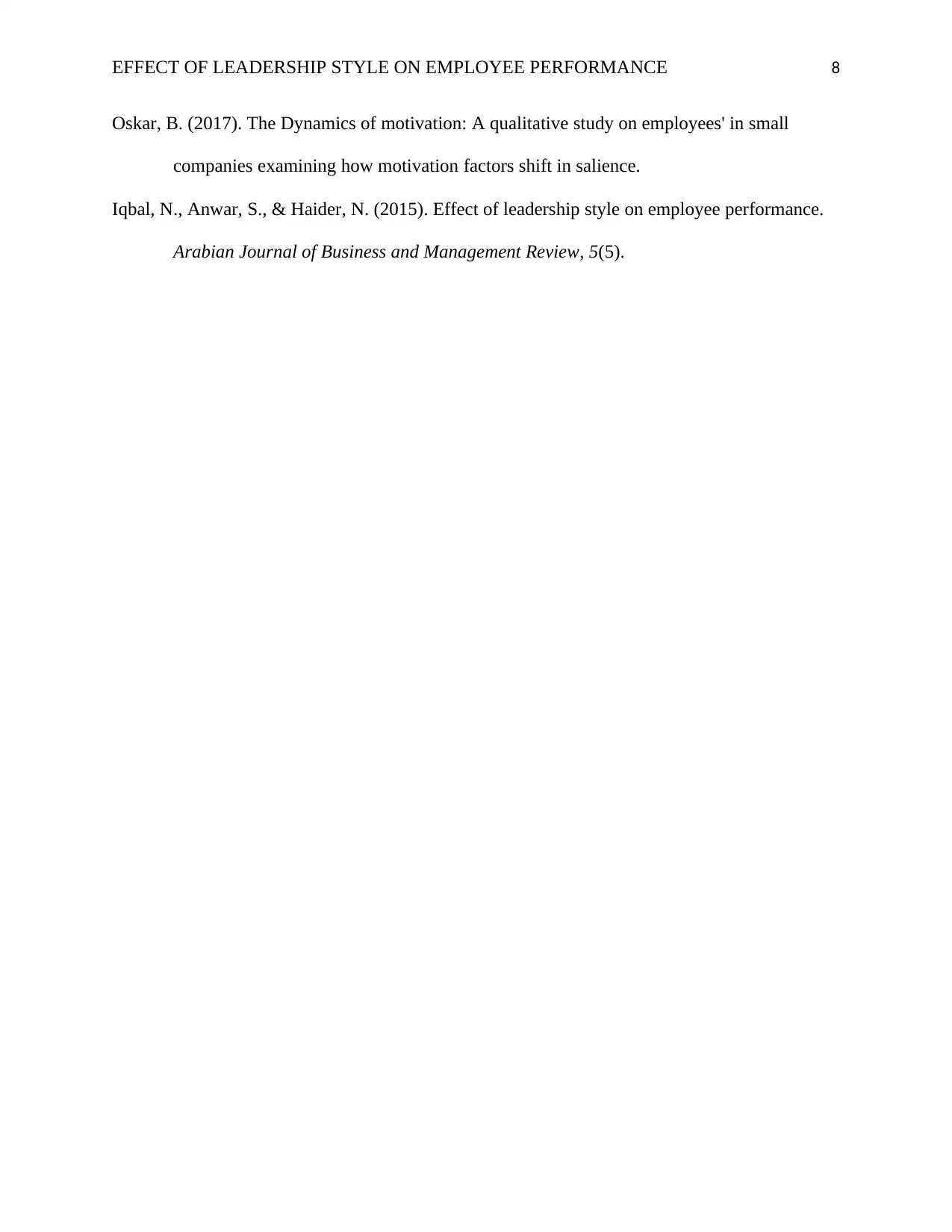
EFFECT OF LEADERSHIP STYLE ON EMPLOYEE PERFORMANCE 8
Oskar, B. (2017). The Dynamics of motivation: A qualitative study on employees' in small
companies examining how motivation factors shift in salience.
Iqbal, N., Anwar, S., & Haider, N. (2015). Effect of leadership style on employee performance.
Arabian Journal of Business and Management Review, 5(5).
Oskar, B. (2017). The Dynamics of motivation: A qualitative study on employees' in small
companies examining how motivation factors shift in salience.
Iqbal, N., Anwar, S., & Haider, N. (2015). Effect of leadership style on employee performance.
Arabian Journal of Business and Management Review, 5(5).
1 out of 8
Related Documents
Your All-in-One AI-Powered Toolkit for Academic Success.
+13062052269
info@desklib.com
Available 24*7 on WhatsApp / Email
![[object Object]](/_next/static/media/star-bottom.7253800d.svg)
Unlock your academic potential
Copyright © 2020–2025 A2Z Services. All Rights Reserved. Developed and managed by ZUCOL.





